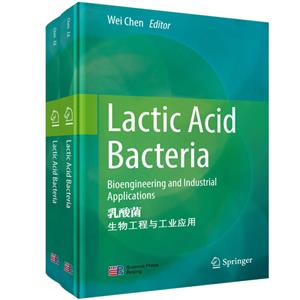包郵 乳酸菌(組學(xué)與功能性評(píng)價(jià),生物工程與工業(yè)應(yīng)用)/英文版/共2卷
-
>
宇宙、量子和人類(lèi)心靈
-
>
氣候文明史
-
>
南極100天
-
>
考研數(shù)學(xué)專(zhuān)題練1200題
-
>
希格斯:“上帝粒子”的發(fā)明與發(fā)現(xiàn)
-
>
神農(nóng)架疊層石:10多億年前遠(yuǎn)古海洋微生物建造的大堡礁
-
>
聲音簡(jiǎn)史
乳酸菌(組學(xué)與功能性評(píng)價(jià),生物工程與工業(yè)應(yīng)用)/英文版/共2卷 版權(quán)信息
- ISBN:9787030691316
- 條形碼:9787030691316 ; 978-7-03-069131-6
- 裝幀:一般膠版紙
- 冊(cè)數(shù):暫無(wú)
- 重量:暫無(wú)
- 所屬分類(lèi):>
乳酸菌(組學(xué)與功能性評(píng)價(jià),生物工程與工業(yè)應(yīng)用)/英文版/共2卷 內(nèi)容簡(jiǎn)介
**卷介紹了乳酸菌領(lǐng)域的近期新研究和新技術(shù),包括比較基因組學(xué)、轉(zhuǎn)錄組學(xué)、蛋白質(zhì)組學(xué)和代謝組學(xué)等,并且針對(duì)乳酸菌的功能評(píng)價(jià)模型與研究歷史展開(kāi)了詳細(xì)的介紹。此外,聚焦目前生命科學(xué)領(lǐng)域的研究熱點(diǎn),本書(shū)還介紹了乳酸菌與腸道健康和宿主免疫力之間的關(guān)系,乳酸菌的安全性評(píng)價(jià)體系和商業(yè)化的對(duì)健康有益的乳酸菌菌株。該書(shū)總結(jié)了乳酸菌在食品和健康方面的生物技術(shù)進(jìn)展,這對(duì)于食品微生物學(xué)、生物工程、食品科學(xué)、營(yíng)養(yǎng)和健康領(lǐng)域的研究人員和研究生將是有用的。第二卷重點(diǎn)介紹了乳酸菌生產(chǎn)的多種活性物質(zhì),主要包括γ-氨基丁酸、雙乙酰、共軛脂肪酸、B族維生素、細(xì)菌素等,同時(shí)乳酸菌也可以用作發(fā)酵劑,在發(fā)酵谷物、果蔬、肉制品、醫(yī)藥領(lǐng)域和動(dòng)物水產(chǎn)養(yǎng)殖等領(lǐng)域均得到廣泛的應(yīng)用。該書(shū)總結(jié)了乳酸菌在生物活性物質(zhì)和發(fā)酵工業(yè)應(yīng)用方面的生物技術(shù)進(jìn)展,這對(duì)于食品微生物學(xué)、生物工程、食品科學(xué)、營(yíng)養(yǎng)和健康領(lǐng)域的研究人員和研究生將是有用的。
乳酸菌(組學(xué)與功能性評(píng)價(jià),生物工程與工業(yè)應(yīng)用)/英文版/共2卷 目錄
1 Lactic Acid Bacteria and γ-Aminobutyric Acid and Diacetyl 1
Shunhe Wang, Pei Chen, and Hui Dang
2 Lactic Acid Bacteria and Conjugated Fatty Acids 21
Wei Chen, Bo Yang, and Jianxin Zhao
3 Lactic Acid Bacteria and B Vitamins 45
Wanqiang Wu and Baixi Zhang
4 Lactic Acid Bacteria and Bacteriocins 67
Qiuxiang Zhang
5 Lactic Acid Bacteria Starter 101
Wei Chen and Feng Hang
6 Lactic Acid Bacteria and Fermented Cereals 155
Bowen Yan and Hao Zhang
7 Lactic Acid Bacteria and Fermented Fruits and Vegetables 191
Bingyong Mao and Shuang Yan
8 Lactic Acid Bacteria and Fermented Meat Products 221
Shumao Cui and Zhexin Fan
9 The Preparation Technology of Pharmaceutical Preparations of Lactic Acid Bacteria 237
Wei Chen and Linlin Wang
10 Lactic Acid Bacteria in Animal Breeding and Aquaculture 267
Gang Wang and Xing Jin
乳酸菌(組學(xué)與功能性評(píng)價(jià),生物工程與工業(yè)應(yīng)用)/英文版/共2卷 節(jié)選
Chapter 1 Lactic Acid Bacteria and γ-Aminobutyric Acid and Diacetyl Shunhe Wang, Pei Chen, and Hui Dang 1.1 Lactic Acid Bacteria and γ-Aminobutyric Acid 1.1.1 Introduction of γ-Aminobutyric Acid 1.1.1.1 γ-Aminobutyric Acid γ-Aminobutyric acid (GABA), or γ-ammonia butyric acid, is a kind of nonprotein amino acid which widely exists in vegetables and animals. It exists in the seeds, roots, and tissue fluid of many plants, such as Glycine L., Panax, herbal, and in animals almost exclusively present in nervous tissues. The content of GABA in brain tissue is 0.1–0.6 mg/g, and immunology research show that substantia nigra contain the highest concentration of GABA (Krajnc et al. 1996). Meanwhile GABA is also present in microorganisms, such as yeast, Lactobacillus, and Escherichia coli. GABA was discovered in the metabolite of plants and microorganisms in 1883. Awapara et al. (1950), Roberts and Frankel (1950), and Udenfriend (1950) found that the content of GABA was relatively high in the brain of mammals, but the biological significance was unknown. Roberts reported that GABA was a product of glutamate through α-decarboxylation. Krnjevi. and Schwartz (1966) researched that GABA played a part in the brain of mammals as an endogenous neurotransmitter and GABA was confirmed as an inhibitory neurotransmitter in the Second International Symposium on GABA in 1975. Many studies in recent years have reported the physiological function of GABA, including delaying senescence of nerve cells, lowering blood pressure, repairing the skin, treating mental illnesses, and regulating cardiac arrhythmia and hormone secretion (He et al. 2007). Scientists from all around the world studied the synthesis technology and its related product. GABA could be produced by chemical synthesis, plant enrichment, and microbiological fermentation. Sawai et al. (2001) researched that the content of GABA in tea could be enhanced through a variable anaerobic-aerobic process. Meanwhile, it also could be produced by controlling the germination condition of brown rice and rice germ. Xia Jiang et al. reported that Lactobacillus brevis CGMCCNO.1306 was isolated from unpasteurized raw milk and the capacity of GABA was 76.36 g/L after the mutation breeding (Xia 2006; Xia et al. 2006). 1.1.1.2 General Physicochemical Property The chemical formula is C4H9NO2 and molar mass is 103.120 g/mol. It appears as a white microcrystalline powder, easily soluble in water, slightly soluble in ethanol, and insoluble in cold ethanol, benzene, and ether. The dissociation constant of pKCOOH and pKNH3 is 4.03 and 10.56, respectively. GABA has no optical rotation, the melting point was 203–204℃. Its products of decomposition were pyrrolidone and water (Chen et al. 2010). In most part, GABA exists in the form of amidogen with positive charge or carboxyl with negative charge. The state of GABA determined its molecular conformation. In the gaseous state, the molecular conformation is highly folded due to the electrostatic interaction of two charged groups; in solid state, the molecular conformation is extended due to the intermolecular interaction between the two groups. When in liquid state, molecular conformations exist in both states. The various conformations of GABA are combined with different receptor proteins, which play significant physiological functions. 1.1.2 GABA Production of Lactic Acid Bacteria GABA In microorganisms GABA is produced from L-glutamate or its sodium salt by α-decarboxylation reaction at the catalysis of glutamate decarboxylase. Glutamate decarboxylase is the single enzyme to generate GABA from L-glutamate or its sodium salt, which was discovered in bacteria, archaea, and eucaryotic microbes. Compared with chemical synthesis and plant enrichment, GABA from microorganism fermentation, which has low cost and high yield, can be used in food safely. Lactic acid bacteria (LAB), as a safe microorganism (GRAS), are widely used in foods, such as yogurt, cheese, and pickles. Many studies show that LAB have glutamate decarboxylase which generates GABA from L-glutamate by decarboxylation reaction. Nomura et al. (1998) reported that the content of GABA was 383 mg/ kg in cheese, in which a strain of Lactococcus lactis 01–7 with high GABA was isolated. Komatsuzaki et al. (2005) researched that a strain of Lactobacillus paracasei NFRI7415 with high GABA was isolated from traditional fermented food and the capacity of GABA was 302 mmol/L. Xu et al. (2002) isolated a strain of Lactococcus lactis with high GABA for the first time interiorly, and the amount of GABA in the fermentation broth was 250 mg/100 ml, which was fermented in 25 L tank for 72 h. It could be used in the development of yogurt or as an ingredient in other foods. Cui et al. (2005) also reported the screening and fermentation conditions of high GABA-producing Lactobacillus, and the capacity of GABA was 5.4 g/L in the fermentation
- >
自卑與超越
- >
我與地壇
- >
回憶愛(ài)瑪儂
- >
李白與唐代文化
- >
龍榆生:詞曲概論/大家小書(shū)
- >
苦雨齋序跋文-周作人自編集
- >
姑媽的寶刀
- >
【精裝繪本】畫(huà)給孩子的中國(guó)神話
















